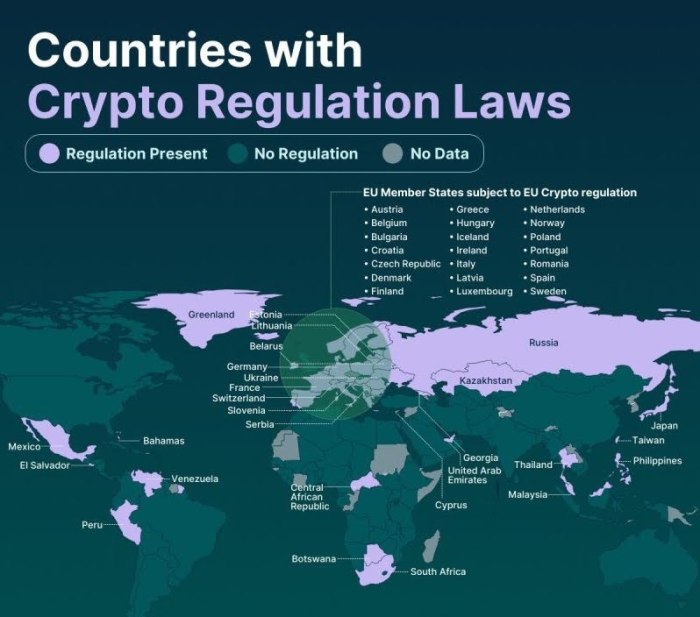Crypto Regulations Around the World are a rapidly evolving landscape, shaping the future of digital assets globally. The decentralized nature of cryptocurrencies presents unique challenges for regulators, leading to a diverse range of approaches across different jurisdictions. From the stringent controls imposed by some nations to the more permissive environments adopted by others, the regulatory framework significantly impacts innovation, investment, and consumer protection within the cryptocurrency market. This exploration delves into the complexities of these regulations, examining their impact on various aspects of the crypto ecosystem.
This analysis will cover key regulatory focuses, including Initial Coin Offerings (ICOs), Security Token Offerings (STOs), cryptocurrency exchanges, stablecoins, taxation, Anti-Money Laundering (AML) and Know Your Customer (KYC) regulations, and consumer protection. We will also explore the roles of central banks and international cooperation in shaping a global regulatory framework for cryptocurrencies, analyzing the impact on innovation and predicting future trends in this dynamic field. The discussion will highlight both the opportunities and challenges inherent in balancing innovation with the need for responsible regulation in the cryptocurrency space.
Overview of Global Crypto Regulatory Landscape
The global regulatory landscape for cryptocurrencies is a complex and rapidly evolving field. Different jurisdictions are adopting diverse approaches, ranging from outright bans to comprehensive regulatory frameworks. This heterogeneity reflects varying levels of technological understanding, economic priorities, and risk tolerance among nations. Understanding these differences is crucial for navigating the international cryptocurrency market.
The current state of cryptocurrency regulation varies significantly across major global economies. Developed nations generally favor a more regulated approach, aiming to balance innovation with consumer protection and financial stability. Developing nations, on the other hand, often grapple with limited resources and expertise, leading to approaches that range from cautious observation to outright prohibition, depending on their specific circumstances and priorities. This divergence in regulatory strategies creates challenges for businesses operating internationally and necessitates careful consideration of jurisdictional specifics.
Regulatory Approaches in Developed and Developing Nations, Crypto Regulations Around the World
Developed nations tend to establish comprehensive regulatory frameworks, often incorporating cryptocurrencies into existing financial regulatory structures. This approach typically involves licensing requirements for cryptocurrency exchanges, anti-money laundering (AML) and know-your-customer (KYC) compliance, and taxation of cryptocurrency transactions. Conversely, developing nations may lack the infrastructure or resources to implement such sophisticated regulatory regimes. Some may choose to ban cryptocurrencies altogether, citing concerns about illicit activities or macroeconomic stability. Others may adopt a more hands-off approach, allowing the market to develop organically while monitoring for potential risks. This often results in a less certain legal environment for businesses and investors.
Comparative Analysis of Crypto Regulatory Frameworks
The following table provides a comparison of cryptocurrency regulatory frameworks in five key jurisdictions:
| Country | Regulatory Body | Key Regulations | Current Status |
|---|---|---|---|
| United States | SEC, CFTC, FinCEN, state-level regulators | Varying regulations at the federal and state levels; ongoing debate on comprehensive framework; focus on securities laws and AML/KYC compliance. | Fragmented and evolving; ongoing legislative efforts to establish a clearer regulatory framework. |
| China | PBOC, other relevant ministries | Complete ban on cryptocurrency trading and mining; strict measures to prevent and suppress cryptocurrency-related activities. | Stringent prohibition remains in effect; ongoing efforts to monitor and enforce the ban. |
| European Union | European Commission, national authorities | Markets in Crypto-Assets (MiCA) regulation aims to create a unified regulatory framework across the EU; focus on licensing, consumer protection, and market integrity. | MiCA is under finalization and expected to come into effect in 2024, creating a more unified and comprehensive approach. |
| Japan | FSA | Strict licensing requirements for cryptocurrency exchanges; AML/KYC compliance; clear regulatory framework for cryptocurrencies as a form of payment. | Relatively well-established and mature regulatory framework; ongoing efforts to adapt to evolving technological developments. |
| Singapore | MAS | Focus on licensing, AML/KYC compliance, and investor protection; a more permissive approach compared to some other jurisdictions, but with robust regulatory oversight. | Progressive and adaptable regulatory framework; ongoing efforts to balance innovation with risk management. |
Regulatory Focus on Specific Crypto Activities

The global regulatory landscape for cryptocurrencies is fragmented and constantly evolving. Different jurisdictions approach the regulation of specific crypto activities with varying degrees of strictness, leading to a complex and often inconsistent framework. This section will examine the regulatory approaches to Initial Coin Offerings (ICOs), Security Token Offerings (STOs), cryptocurrency exchanges, and stablecoins.
Initial Coin Offerings (ICOs) and Security Token Offerings (STOs)
ICOs and STOs represent distinct methods of fundraising using cryptocurrencies. While both involve the issuance of tokens, their regulatory treatment differs significantly depending on whether the token is considered a security. ICOs, historically, often lacked robust regulatory oversight, leading to numerous fraudulent schemes. STOs, on the other hand, attempt to comply with existing securities laws by structuring the token offering as a regulated security. This often involves adhering to strict disclosure requirements and investor accreditation processes. The classification of a token as a security or utility token is often the key determinant of applicable regulations. For instance, the Howey Test, used in the United States, is frequently applied to determine whether a token meets the definition of a security. Many jurisdictions now require ICOs and STOs to register with relevant financial authorities or comply with specific licensing requirements before launching a token sale. Failure to comply can result in significant penalties, including fines and legal action.
Cryptocurrency Exchanges and Trading Platforms
Cryptocurrency exchanges and trading platforms facilitate the buying, selling, and trading of cryptocurrencies. Regulations governing these platforms vary considerably across jurisdictions. Some countries have established comprehensive licensing regimes for cryptocurrency exchanges, requiring them to meet stringent anti-money laundering (AML) and know-your-customer (KYC) compliance standards, as well as robust security protocols to protect customer assets. Other jurisdictions have taken a more hands-off approach, resulting in a less regulated environment. This lack of regulation can lead to increased risks for investors, including scams, fraud, and market manipulation. The regulatory focus often includes requirements for robust security measures, compliance with AML/KYC regulations, and transparent operational practices. For example, some jurisdictions mandate regular audits of exchange reserves and require exchanges to maintain adequate insurance coverage to protect against potential losses.
Stablecoins and Implications for Financial Stability
Stablecoins, designed to maintain a stable value pegged to a fiat currency or other asset, have attracted significant attention from regulators due to their potential implications for financial stability. Concerns exist about their potential to be used for illicit activities, their vulnerability to runs, and their potential impact on monetary policy. Regulatory frameworks for stablecoins are still in their nascent stages, with various jurisdictions exploring different approaches. Some jurisdictions are exploring licensing requirements for stablecoin issuers, similar to those imposed on banks and other financial institutions. Others are focusing on ensuring transparency and reserve requirements to mitigate risks. The potential systemic risk associated with widely adopted stablecoins is a key concern for regulators globally, prompting increased scrutiny and a push for clearer regulatory frameworks. For example, the collapse of TerraUSD (UST) highlighted the risks associated with algorithmic stablecoins and the need for robust regulatory oversight.
Taxation of Cryptocurrencies
The tax treatment of cryptocurrencies varies significantly across jurisdictions, reflecting the ongoing evolution of both cryptocurrency technology and tax law. Understanding these differences is crucial for individuals and businesses involved in cryptocurrency transactions, as failure to comply with applicable tax regulations can lead to substantial penalties. This section will explore the diverse approaches to cryptocurrency taxation, focusing on capital gains taxes and the specific implications for mining and staking activities.
The taxability of cryptocurrency transactions largely hinges on the classification of cryptocurrency itself. Some countries treat cryptocurrency as property, similar to stocks or real estate, while others classify it as a currency, a commodity, or even a security, depending on the specific circumstances. This classification directly impacts how profits or losses from cryptocurrency transactions are taxed.
Capital Gains Taxes on Cryptocurrency Transactions
Capital gains taxes apply when a cryptocurrency is sold or exchanged for a profit. The taxable gain is the difference between the selling price and the original cost basis (the price at which the cryptocurrency was acquired). The cost basis can be determined using methods such as first-in, first-out (FIFO), last-in, first-out (LIFO), or specific identification, depending on the jurisdiction’s regulations and the taxpayer’s preference. For example, in the United States, capital gains tax rates vary depending on the holding period and the taxpayer’s income bracket. Short-term gains (held for one year or less) are taxed at ordinary income rates, while long-term gains (held for more than one year) are taxed at preferential capital gains rates. In contrast, some countries may not have specific capital gains tax rates for cryptocurrencies, instead applying their general capital gains tax regime. The complexities increase further when considering exchanges of cryptocurrencies for other cryptocurrencies or goods and services. For instance, a trade of Bitcoin for Ethereum would be considered a taxable event, with the gain or loss calculated based on the fair market value of both cryptocurrencies at the time of the exchange.
Tax Implications of Cryptocurrency Mining
Cryptocurrency mining involves using computational power to solve complex mathematical problems and validate transactions on a blockchain network. The reward for this activity is typically the newly minted cryptocurrency. The tax treatment of mining rewards varies considerably across jurisdictions. In some countries, the mining rewards are treated as taxable income in the year they are received, similar to wages or salaries. This income is subject to the relevant income tax rates. Other jurisdictions might consider the mining rewards as capital gains, taxable only upon sale or exchange of the mined cryptocurrency. The value of the mining rewards at the time of receipt is crucial for calculating the tax liability. Factors like the cost of electricity and equipment used in mining can also be deducted to reduce the taxable income, depending on local tax laws. For example, a miner in the UK might have to pay income tax on their mining rewards, while a miner in Germany might face different rules depending on the classification of mining activities under German tax law.
Tax Implications of Cryptocurrency Staking
Cryptocurrency staking involves locking up cryptocurrency to help validate transactions and secure a blockchain network. In return, stakers receive rewards in the form of newly minted cryptocurrency or transaction fees. Similar to mining, the tax treatment of staking rewards varies across jurisdictions. Some countries may treat staking rewards as taxable income, while others might classify them as capital gains. The calculation of the tax liability will involve determining the fair market value of the staking rewards at the time they are received. Costs associated with staking, such as transaction fees or platform fees, might be deductible. For example, a user staking ETH on a platform might face tax implications on the ETH rewards earned, with the exact treatment depending on the country of residence and specific tax laws.
Anti-Money Laundering (AML) and Know Your Customer (KYC) Regulations
The rise of cryptocurrencies has presented significant challenges to traditional financial regulatory frameworks, particularly concerning Anti-Money Laundering (AML) and Know Your Customer (KYC) regulations. These regulations, designed to prevent illicit activities like money laundering and terrorist financing, are crucial for maintaining the integrity of the financial system. Their application to the decentralized and pseudonymous nature of cryptocurrencies, however, requires innovative approaches and careful consideration.
Cryptocurrency exchanges, acting as intermediaries between fiat currency and cryptocurrencies, are the primary focus of AML/KYC enforcement. These regulations aim to ensure transparency and traceability within the cryptocurrency ecosystem, making it more difficult for criminals to utilize cryptocurrencies for illegal purposes.
AML/KYC Measures Implemented by Cryptocurrency Exchanges
Cryptocurrency exchanges employ various AML/KYC measures to comply with regulatory requirements and mitigate risks. These measures typically involve verifying the identity of users through the collection and verification of personal information, including government-issued identification documents, proof of address, and sometimes even biometric data. Transaction monitoring systems are also employed to detect suspicious activities, such as large or unusual transactions, patterns indicative of money laundering, or transactions linked to known sanctioned entities. These systems often utilize advanced algorithms and machine learning to analyze vast amounts of transaction data and flag potential red flags. Furthermore, exchanges often implement limitations on transaction sizes and withdrawal amounts for unverified or newly registered accounts, to prevent immediate exploitation. Finally, many exchanges collaborate with third-party compliance providers to leverage their expertise and technology for enhanced AML/KYC processes.
Challenges in Enforcing AML/KYC Regulations in Decentralized Cryptocurrencies
The decentralized and pseudonymous nature of many cryptocurrencies presents significant challenges to AML/KYC enforcement. Unlike traditional financial institutions, cryptocurrency transactions are not typically processed through centralized intermediaries that can easily be monitored and regulated. This makes it difficult to track the flow of funds and identify the individuals involved in suspicious activities. The use of mixers or tumblers, designed to obscure the origin and destination of cryptocurrency transactions, further complicates enforcement efforts. Moreover, the global and borderless nature of cryptocurrencies makes it difficult for individual jurisdictions to effectively regulate transactions that may traverse multiple countries and regulatory frameworks. The rapid evolution of the cryptocurrency landscape, with the emergence of new technologies and protocols, also presents ongoing challenges for regulators in keeping up with innovative methods used to circumvent AML/KYC measures. The lack of uniform global standards and the varying levels of regulatory enforcement across different jurisdictions exacerbate these challenges. For instance, while some jurisdictions have robust AML/KYC frameworks for crypto exchanges, others may have limited or no regulation at all, creating havens for illicit activities. This jurisdictional arbitrage further complicates international cooperation and effective enforcement.
Consumer Protection in the Crypto Market

The volatile and often opaque nature of the cryptocurrency market presents significant risks to consumers. While traditional financial markets benefit from established regulatory frameworks designed to protect investors, the decentralized and global character of cryptocurrencies necessitates a unique approach to consumer protection. Existing frameworks offer some level of protection, but significant gaps remain, requiring innovative regulatory solutions to address the specific vulnerabilities of consumers in this rapidly evolving landscape.
Existing consumer protection frameworks, while not explicitly designed for cryptocurrencies, offer some degree of protection. For example, laws against fraud and misrepresentation apply to cryptocurrency investments as they do to other investments. Furthermore, some jurisdictions have introduced specific regulations addressing aspects of cryptocurrency trading, such as anti-money laundering (AML) and know your customer (KYC) rules, which indirectly enhance consumer protection by aiming to curb illicit activities and promote market transparency. However, these measures often fall short of providing comprehensive protection tailored to the unique risks inherent in cryptocurrency investments.
Vulnerabilities of Consumers in the Crypto Market and Potential Regulatory Solutions
Consumers in the crypto market face numerous vulnerabilities. These include scams, fraudulent projects, market manipulation, and the lack of readily available recourse in case of losses. The decentralized and borderless nature of cryptocurrencies makes it difficult to track perpetrators and enforce legal judgments across jurisdictions. The complexity of blockchain technology and cryptocurrency trading platforms also contributes to consumer vulnerability, making it challenging for individuals to fully understand the risks involved. Potential regulatory solutions include enhancing transparency requirements for cryptocurrency projects, establishing clear guidelines for marketing and advertising, improving investor education initiatives, and strengthening cross-border cooperation to combat fraud and enforce regulations effectively. The establishment of consumer protection agencies specifically focused on the crypto market, empowered to investigate complaints and take enforcement action, would also be a significant step forward. For example, a regulatory body could mandate independent audits of cryptocurrency projects before they are allowed to offer tokens to the public, thereby reducing the risk of scams. Furthermore, clear and easily accessible information regarding the risks associated with cryptocurrency investments should be mandated for all platforms offering such investments.
Hypothetical Consumer Protection Framework for Cryptocurrency Investments
A comprehensive consumer protection framework for cryptocurrency investments should encompass several key elements. First, it needs to establish clear definitions and classifications for various types of crypto assets to facilitate better regulation and consumer understanding. Second, it must mandate robust disclosure requirements for cryptocurrency projects, including detailed information about the project’s team, technology, business model, and financial risks. Third, a system for registering and licensing cryptocurrency exchanges and other service providers should be implemented to ensure compliance with regulatory standards and provide a recourse mechanism for consumers in case of disputes. Fourth, investor education programs are crucial to equip consumers with the knowledge and skills necessary to navigate the complexities of the crypto market. Finally, the framework should establish an effective dispute resolution mechanism to facilitate the fair and efficient settlement of disputes between consumers and cryptocurrency businesses. This could involve a dedicated regulatory body with the authority to investigate complaints, impose sanctions, and provide redress to harmed consumers. The framework should also emphasize cross-border cooperation to address the global nature of the cryptocurrency market and ensure consistent standards of consumer protection worldwide. A successful framework would likely involve a multi-faceted approach incorporating elements of self-regulation, industry standards, and government oversight. For example, a system of independent audits could be mandated, along with a publicly accessible database of audited projects, thereby providing consumers with more transparency and confidence in their investment decisions.
The Role of Central Banks in Crypto Regulation
Central banks globally are increasingly recognizing the significance of cryptocurrencies and their potential impact on financial systems. Their responses, however, vary widely, reflecting differing economic priorities, levels of technological readiness, and risk tolerance. This multifaceted approach necessitates a careful examination of their strategies and the potential implications for the future of both cryptocurrencies and traditional finance.
Central banks are adopting diverse strategies in response to the rise of cryptocurrencies. Some are actively exploring the development and implementation of Central Bank Digital Currencies (CBDCs), while others maintain a more cautious, wait-and-see approach, focusing instead on monitoring and mitigating risks associated with crypto activities within their jurisdictions. This range of responses reflects the complex interplay of national economic goals, technological capabilities, and regulatory frameworks.
Central Bank Approaches to Cryptocurrencies
The spectrum of central bank responses to cryptocurrencies is broad. Some, like the European Central Bank and the People’s Bank of China, are actively researching and developing CBDCs, aiming to modernize payment systems and potentially enhance monetary policy effectiveness. Others, such as the Federal Reserve in the United States, are proceeding more cautiously, conducting research and assessing potential risks before committing to a full-scale CBDC implementation. Still others prioritize regulating existing crypto activities, focusing on issues like money laundering and consumer protection, rather than developing their own digital currencies. These varied approaches highlight the lack of a universally agreed-upon regulatory framework for cryptocurrencies.
Central Bank Digital Currency (CBDC) Exploration
Many central banks are actively exploring the potential benefits and challenges of issuing CBDCs. These digital versions of fiat currencies, issued and managed by central banks, aim to offer several advantages. For example, they could potentially improve payment efficiency, reduce reliance on intermediaries, and enhance financial inclusion by providing access to financial services for unbanked populations. However, the implementation of CBDCs also presents significant technical and policy challenges, including the need for robust cybersecurity infrastructure, considerations of privacy, and the potential impact on the existing financial system. The ongoing research and pilot programs by numerous central banks demonstrate a significant global interest in this technology, although the path to widespread adoption remains uncertain. For example, the Bahamas already has a functioning CBDC, the Sand Dollar, while other nations are in various stages of experimentation and development.
Potential Impact of CBDCs on Cryptocurrency Regulation
The widespread adoption of CBDCs could significantly reshape the cryptocurrency regulatory landscape. A successful CBDC could potentially reduce the demand for cryptocurrencies as a medium of exchange and store of value, potentially lessening the urgency for comprehensive cryptocurrency regulation. Conversely, the existence of a CBDC could also lead to more stringent regulations on cryptocurrencies to ensure financial stability and prevent the emergence of parallel, unregulated financial systems. The interaction between CBDCs and existing cryptocurrencies is a complex and evolving area, and its ultimate impact remains uncertain, depending heavily on the design and implementation of individual CBDCs and the evolution of the broader cryptocurrency market. The interplay between these two systems will undoubtedly influence future regulatory frameworks.
International Cooperation on Crypto Regulation: Crypto Regulations Around The World
The rapid growth and global reach of cryptocurrencies necessitate international collaboration to establish a consistent and effective regulatory framework. Without coordinated efforts, regulatory arbitrage and inconsistencies across jurisdictions could hinder innovation, increase financial crime, and undermine investor protection. This section explores existing international cooperation initiatives, the challenges of global harmonization, and strategies for improved coordination.
Existing international collaborations are primarily focused on information sharing and the development of common standards, rather than legally binding global regulations. This reflects the inherent difficulty in harmonizing diverse legal and economic systems. While a completely unified global approach remains elusive, progress is being made through various channels.
Existing International Collaborations and Initiatives
Several organizations and forums play a key role in fostering international dialogue and cooperation on crypto regulation. The Financial Stability Board (FSB), for example, has published numerous reports and recommendations on cryptoasset regulation, focusing on the risks to financial stability. Similarly, the Organisation for Economic Co-operation and Development (OECD) is actively involved in developing international tax standards relevant to cryptocurrencies. Regional bodies, such as the European Union and the Financial Action Task Force (FATF), also play a significant role by setting standards and promoting their adoption by member states. These initiatives involve the sharing of best practices, the development of common methodologies for risk assessment, and the promotion of consistent regulatory approaches. However, the level of enforcement and compliance varies significantly across jurisdictions.
Challenges and Opportunities for Global Harmonization
Harmonizing crypto regulations globally presents considerable challenges. Differing legal traditions, economic priorities, and levels of technological expertise create significant hurdles. Moreover, the decentralized and borderless nature of cryptocurrencies makes enforcement complex. However, opportunities exist to leverage international cooperation to address these challenges. A globally coordinated approach could enhance regulatory effectiveness, reduce regulatory arbitrage, and foster innovation by creating a more predictable and transparent regulatory environment. This could attract investment and promote the responsible development of the crypto ecosystem.
Strategies for Enhanced International Cooperation
Enhanced international cooperation requires a multi-pronged approach. This includes strengthening existing collaborative platforms, such as the FSB and FATF, by providing them with increased resources and authority. It also involves fostering greater dialogue and information sharing between regulators across jurisdictions. Developing common standards and methodologies for assessing risks and evaluating compliance is crucial. Finally, exploring the potential for multilateral agreements or treaties, while acknowledging the challenges in achieving global consensus, could create a stronger foundation for harmonized regulation. This might involve focusing on specific areas of common concern, such as AML/KYC compliance or consumer protection, before attempting to harmonize broader aspects of regulation. A phased approach, prioritizing areas of consensus and building towards broader harmonization over time, is likely to be more effective than aiming for immediate complete unification.
Impact of Crypto Regulation on Innovation

The relationship between cryptocurrency regulation and innovation is complex and multifaceted. Different regulatory approaches, ranging from highly restrictive to largely permissive, significantly influence the pace and direction of cryptocurrency development. Understanding these impacts is crucial for policymakers aiming to balance the potential benefits of cryptocurrencies with the need for consumer protection and financial stability.
Regulatory approaches significantly shape the cryptocurrency landscape. Restrictive regulations, often characterized by stringent licensing requirements, limitations on trading activities, and heavy taxation, can stifle innovation by increasing barriers to entry for new projects and businesses. This can lead to a slowdown in the development of new technologies and applications, potentially hindering the growth of the entire ecosystem. Conversely, permissive environments, while offering greater freedom for experimentation and development, also carry risks, such as increased potential for fraud, market manipulation, and consumer harm. Finding the optimal balance is a significant challenge for regulators worldwide.
Effects of Restrictive Regulatory Approaches on Cryptocurrency Innovation
Strict regulations can hinder the development of innovative crypto projects. High compliance costs associated with licensing and reporting requirements disproportionately affect smaller startups and independent developers, limiting their ability to compete with larger, more established players. This can lead to a consolidation of the market, reducing diversity and potentially slowing down the pace of innovation. For example, stringent KYC/AML regulations, while necessary for combating illicit activities, can create significant hurdles for developers seeking to onboard users, particularly in regions with less developed financial infrastructure. The complexity and cost of complying with such regulations can discourage participation, limiting the overall growth and adoption of cryptocurrencies.
Effects of Permissive Regulatory Approaches on Cryptocurrency Innovation
While a permissive regulatory environment fosters a more dynamic and innovative cryptocurrency ecosystem, it also carries inherent risks. The lack of clear guidelines and oversight can lead to increased market volatility, scams, and instances of fraud. This can erode consumer trust and ultimately hinder the long-term growth of the sector. The absence of robust consumer protection mechanisms in a permissive environment can also expose users to significant financial losses. For instance, the initial coin offering (ICO) boom of 2017, characterized by a largely unregulated environment, saw numerous fraudulent projects raise millions of dollars before collapsing, leaving investors with substantial losses. This highlights the need for a balanced approach that encourages innovation while safeguarding consumers.
Potential Unintended Consequences of Specific Regulatory Measures
Regulatory measures, even those well-intentioned, can have unintended consequences. For example, regulations aimed at preventing money laundering through cryptocurrencies could inadvertently drive illicit activities to less regulated jurisdictions, creating a “regulatory arbitrage” effect. Similarly, taxes on cryptocurrency transactions could disproportionately affect smaller investors and developers, hindering participation and innovation. Furthermore, overly complex regulatory frameworks can lead to compliance burdens that are difficult and costly for businesses to navigate, potentially slowing down development and limiting competition. A thorough cost-benefit analysis of any regulatory measure is essential to minimize such unintended consequences.
Future Trends in Crypto Regulation
The regulatory landscape for cryptocurrencies is constantly evolving, driven by technological advancements, market volatility, and growing public awareness. Predicting the future with certainty is impossible, but analyzing current trends and emerging challenges allows us to anticipate likely developments in global crypto regulation. We can expect a continued push towards greater clarity and harmonization, though the path will likely be uneven and vary significantly across jurisdictions.
The increasing sophistication of crypto technologies and their integration into mainstream finance present unique challenges for regulators. The decentralized nature of many crypto projects inherently complicates enforcement and necessitates international collaboration. The following sections explore some of the key trends and challenges expected in the coming years.
Increased Regulatory Scrutiny of Decentralized Finance (DeFi)
DeFi’s decentralized and pseudonymous nature poses significant regulatory challenges. Current Know Your Customer (KYC) and Anti-Money Laundering (AML) regulations are largely designed for centralized financial institutions and struggle to effectively address the complexities of DeFi protocols. Expect to see regulators increasingly focus on identifying and regulating key actors within DeFi ecosystems, such as developers, auditors, and liquidity providers, potentially through a combination of licensing requirements, reporting obligations, and enhanced monitoring of on-chain activity. The regulatory approach will likely vary depending on the specific DeFi application; for example, lending and borrowing platforms might face stricter scrutiny than decentralized exchanges. This will necessitate the development of innovative regulatory frameworks capable of adapting to the dynamic and evolving nature of DeFi. The regulatory response will likely be iterative, learning from enforcement actions and adapting to technological innovations within DeFi.
NFT Regulation and Intellectual Property Rights
Non-Fungible Tokens (NFTs) present a novel challenge for regulators grappling with intellectual property rights, taxation, and consumer protection. The use of NFTs in various sectors, from art and collectibles to gaming and metaverse experiences, necessitates a clear regulatory framework to address issues such as copyright infringement, fraud, and market manipulation. Expect to see regulators examining how existing intellectual property laws apply to NFTs and whether new regulations are needed to address unique aspects of the NFT market. This could involve clarifying ownership rights, establishing standards for authentication and provenance, and protecting consumers from scams and fraudulent activities related to NFTs. Cases of NFT-related fraud and copyright infringement are already emerging, prompting regulatory action to protect creators and consumers alike.
Timeline of Potential Future Regulatory Milestones
The following timeline Artikels potential future regulatory milestones and their expected impact, recognizing that these are predictions and the actual timeline may differ:
| Year | Milestone | Expected Impact |
|---|---|---|
| 2024-2025 | Increased international cooperation on crypto regulation, leading to more harmonized standards. | Reduced regulatory arbitrage, increased investor protection, and a more stable global crypto market. |
| 2025-2027 | Significant regulatory frameworks for DeFi and NFTs emerge in major jurisdictions. | Increased clarity for businesses operating in these sectors, potentially leading to greater adoption and innovation. However, overly restrictive regulations could stifle innovation. |
| 2028-2030 | Development of global standards for stablecoin regulation, addressing systemic risk and consumer protection. | Increased stability in the crypto market and reduced risk of financial instability. |
“The future of crypto regulation will likely involve a blend of traditional financial regulatory approaches adapted to the unique characteristics of crypto assets, alongside innovative regulatory tools designed to address the specific challenges posed by decentralized technologies.”
Final Summary
Navigating the complex web of Crypto Regulations Around the World requires a nuanced understanding of the diverse approaches adopted by different nations. While a globally harmonized regulatory framework remains a distant goal, the ongoing dialogue and collaborations between regulators and industry stakeholders are crucial for fostering a sustainable and innovative cryptocurrency ecosystem. The future of crypto regulation hinges on finding a balance between protecting consumers and investors, preventing illicit activities, and encouraging the responsible development of this transformative technology. Continued monitoring of evolving regulatory landscapes and technological advancements will be essential in this ongoing process.
Crypto regulations are a complex and evolving landscape globally, varying significantly between jurisdictions. Understanding these differences is crucial, but equally important is safeguarding your investments. To learn practical steps for bolstering your crypto security, consult this helpful guide: How to Protect Your Crypto Assets. Ultimately, proactive security measures, coupled with awareness of regulatory frameworks, offer the best protection for your crypto holdings.
Global crypto regulations are a complex and evolving landscape, varying significantly between jurisdictions. This regulatory uncertainty impacts not only traditional crypto trading but also emerging areas like charitable giving. Understanding these implications is crucial, especially considering the rise of innovative philanthropic initiatives, such as those detailed in this insightful article on Crypto Philanthropy: Giving Back with Blockchain.
Ultimately, clear regulatory frameworks will be key to unlocking the full potential of blockchain for social good while mitigating associated risks.
Crypto regulations are a complex and evolving landscape globally, varying significantly between jurisdictions. Understanding the mechanics of decentralized finance is crucial for navigating this, and a key component is grasping the intricacies of liquidity pools; for a clearer explanation, check out this helpful resource on Understanding Liquidity Pools. This knowledge is increasingly relevant as regulatory bodies worldwide grapple with the implications of decentralized finance for their existing frameworks.





